Chopping Mall
Chopping Mall was my first blog, which I started way back in 2009. It was dedicated exlcusively to ridiculous and terrible films, which I watched a lot of back then. (So much time, so little work!)
I’ve resuced the posts from oblivion, to be preserved here for …uh… whatever.
It’s a pretty clunky process getting them out of blogspot (XML export, eww) and into here, so there may be a few formatting issues.
Torso
**Ah, 1970s Italian films. There’s really nothing like them. I’m not nearly well versed enough in cinema history to know what it was that fuelled the explosion of fabulous Italian cinema in the late 60s and 70s but I’m glad it happened. From Spaghetti Westerns to supernatural slashers, a number of my favourite films, directors and film scores come from the era. **
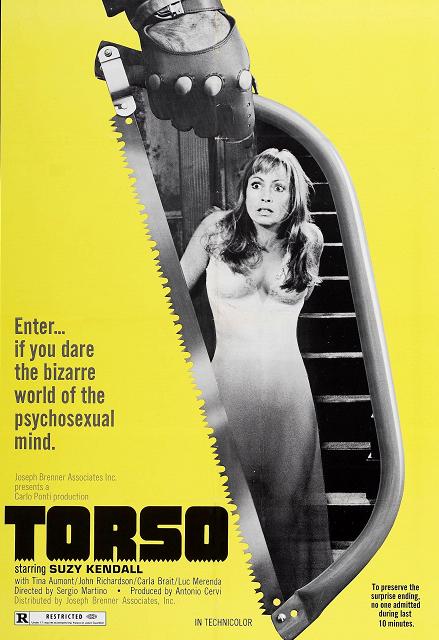
More often than not, these films get unfairly dismissed or overlooked. With large multi-lingual casts speaking whichever language came naturally to them and then being dubbed for release, cheap sets and often clumsy dialogue, a lot of modern film fans sadly mistake these for bad films. They’re not. With the exception of a few well-known greats - like Sergio Leone and Ennio Morricone - most of the star-players of Italian cinema seem to be restricted to only cult appreciation. It’s a shame because so many of these films are beautifully shot and scored, and ought to be better known.
Torso, today’s film, is a giallo flick from Sergio Martino. Like so many of the genre, a number of artsy, rich, female American students meet their end at the hands of a sadistic sexually driven killer (the Italian title translates as The Bodies Presented Traces of Carnal Violence…). Of course, the aim is to catch the killer but you can never really ignore the obvious glee the film takes in punishing these confident, promiscuous women. Besides the obvious sexism - which these films held in common with most other films of the era - the Italian cinema cycles are so confusingly anti-American. Just as the Spaghetti Western took a classic American good-versus-bad narrative and turned most of the Americans into greedy, cold-blooded murderers, mercenaries and cowards, Giallo films are obsessed with Americans but brutal towards them too. Here, the Italian art professor registers his surprise that his student, “a product of American technology”, could possibly have real feelings for art. He suggests that perhaps her real reason for being in Perugia is to “buy the coliseum”. The irony of these films’ resistance to American capitalism being delivered side-by-side with English dubbed dialogue for sale to foreign markets is apparently lost on the film-makers…
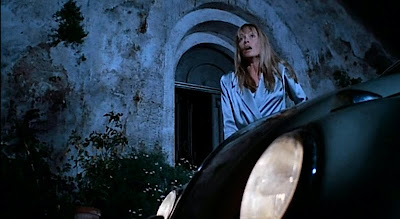
Anyway, in Torso we have a bunch of art students being picked of by a killer. It’s not really the plot or the mystery that holds the attention here so much as the tension and drama surrounding the murders. The first death, early in the story, is a masterpiece of suspense. A couple have sped off from class to a deserted spot to have sex in their bright-red mini (it is the 70s…). The camera lurks in the bushes, creeping around the car for a better view, making the viewer just as sleazy a voyeur as the masked man whose viewpoint we are seeing. Expendable Boyfriend #1 spots the masked man and charges out of the car and into the undergrowth in pursuit. We’re left alone with Flo in the car, the camera still lurching uneasily, as plucked strings warn of what’s to come. You know she’s going to die. But that’s not the point. Even though it’s predictable as can be, with plenty of the those moments where you just want to scream “NO, no, no, stay in the car!”, at the hapless soon-to-be-victim, the real art of the seen is in the buildup to the inevitable. The strings get more insistent. Someone in the orchestra has found a drum and begins gently tapping it. The camera lurches more awkwardly. We see a flash of leather gloves, a movement in the bushes, a peeping figure round the wall. Suddenly it’s all crescendo and murder.
Throughout, the score and cinematography are what really drive this film. Even in moments of calm the camera has a tendency to creep around obstacles in a disarming manner. As with more famous examples, such as Argento’s Proffondo Rosso / Deep Red, a certain amount of the mystery revolves around seeing: mistakes, confusion and half-glimpsed actions lead detectives and characters astray and the viewer becomes a part of the voyeurism that drives the story. The camera shoots from face to face, watching people watching. The score is similarly impressive: silence is used to good effect, and the absence of music is often as tension-building as the music itself. When the music does kick in, little recurring patterns foreshadow moments of violence and build towards violent, noisy bursts. Guido and Marizio de Angelis did a very good job here.
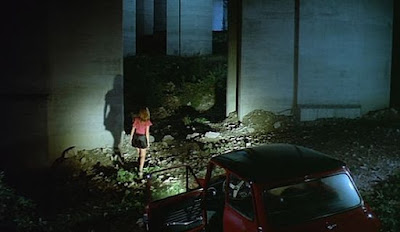
Torso is not the giallo I’d suggest for anyone’s first taste of the genre - probably some Argento would be as good a start as any - but it’s a decent film. However much the dialogue and plot may be somewhat clumsy, there’s a lot of style and tension in it that is all too often missing from modern films.
NO/GLOSS Leeds
The weekend of the 8th & 9th of September saw the launch of Leeds’ first DIY and experimental film festival No/Gloss. As a big fan of film festivals with half-an-eye on experimental film this was pretty exciting. I was only able to attend for one of the two days but I had a great time there.
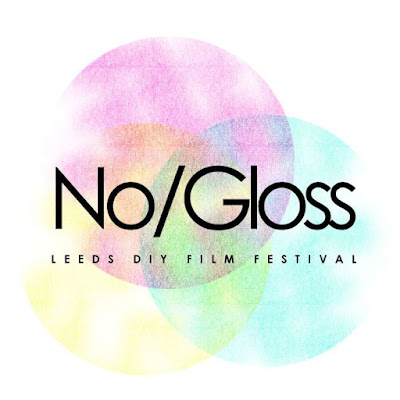
Keeping with the DIY aesthetic, the organisers held it in Wharf Chambers - a co-operatively run Arts-space near(ish) to the Corn Exchange, Leeds. This meant that festival goers could take advantage of the Sam Smiths beer on offer as well as some pretty tasty vegan food. A crowd of film-fans had descended like hungry-wolves on the black-bean paté sandwiches (would hungry wolves eat black bean paté? Not so sure…) but I can vouch for the herb tofu. Great stuff.
The set-up in place at the main screen saw films being shown in three sessions with short breaks between each batch of films. There was a second screen as well, with a long list of shorts that were on a rolling playlist. Sadly, this screen got a bit lost amid the bar, food-counter and conversation of the main room so I didn’t really see very much that was shown on it. But the glimpses I caught did seem interesting.
I’ll write a separate post to review some of the films over the next couple of days, so for now I’ll content myself with saying that the films were varied and interesting. The speed which the schedule see-sawed between funny and depressing did seem a little awkward - finished watching a gritty investigation on homelessness in Manchester? Here’s something funny! - but perhaps that served to emphasise the sheer variety. I’ll put a couple of my favourites at the end.
All in all, NO/GLOSS was a triumph (from the point of view of a punter, at least). And I sincerely hope we’ll see future instalments of this welcome addition to Leeds’ busy cultural calendar.
Some of the best shorts:
Probably my absolute favourite. Bottle by Kirsten Lepore. One of those films that reminds you what fabulous things you can do with a little patience and a whole lot of imagination. A lovely film.
Post Fracas by Xander Robbin is a completely bonkers look at the feelings experienced by a family after being humiliated on a TV-gameshow. A lot of fun
POST FRACAS from Xander Robin on Vimeo.
Surface ii by Sam Spreckley is a beautiful abstract piece. Mesmerising.
Surface ii from sam spreckley on Vimeo.
On Her Majesty's Secret Service
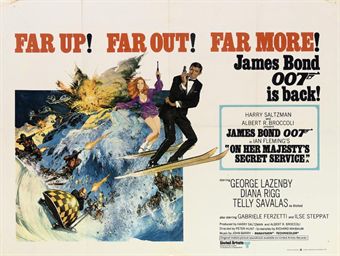
In my last post on a James Bond film, You Only Live Twice, I admitted that the James Bond project was moving along somewhat slowly. Inwardly, I promised myself that I’d speed it up a bit, crack through a few more films and get on with it. But then I looked at the next film on the list: On Her Majesty’s Secret Service. Oh dear.
OHMSS is a film I’d only seen once. It has a reputation as a low-point of the Bond series: people can argue forever about who their favourite Bond is but none of them ever say George Lazenby. Ever. More than that, it’s one of the very few Bond films that, after watching it, I never felt the need to return to again. But that was years ago. Surely my memory was deceiving me? Surely it wasn’t that bad?
It was.
Well… maybe not entirely as bad as I remembered. Just mostly as bad. There are a few decent moments and sequences in it but, for the most part, this is a pretty dull film. First off, it’s slow. Bond films usually move along at a fairly brisk pace - conversation, fight, conversation, fight, etc. etc - but OHMSS just crawls along. Although the plot itself is no better or worse than most other Bond films - Blofeld + world domination + mind control - it just takes forever to actually get exciting. When it does pick up, the film’s actually not bad. The final, say, 20 minutes are pretty pacey. We have a bobsled-run chase/fight, some decent explosions and good gunfights. It’s just such a shame it took so long to get there!
There’s basically two ways of looking at OHMSS: if you treat it as a Bond film, it’s a disappointment. The tone’s all wrong, Lazenby isn’t a great Bond and Telly Savalas is a rubbish Blofeld. On the other hand, if treated as a generic spy/action flick it’s pretty decent. The [spoilers!] grim ending is so very out of place amongst Bond films: usually marooned in the sea/jungle/desert cosying up to a beautiful woman, Lazenby’s Bond is left biting back tears, sat next to his dead wife. It’s not a bad ending - but it’s not Bond.
Still, OHMSS was slightly-less-bad than I had expected, which is pretty much all I was hoping for. Hello and goodbye Mr Lazenby. Next time it’s back to Connery…
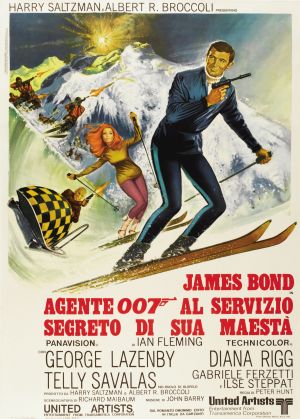
[REC]3 Génesis

I arrived at this film with high hopes. The first [REC] is a film I absolutely love. Studying Spanish and being mad-keen on zombie films, it seemed almost too good to be true that one of the twenty-first century’s best zombie films was filmed by two Spanish directors in an appartment block in Barcelona. It’s a powerful, scary zombie film (that staircase death!) that managed to breath new life into both the zombie and the found-footage genres. Impressive stuff.
The second in the series was by no means as good but it was still streets ahead of most of the competition. Balaguero and Plaza played around with the restrictions of the found-footage film, spiced up the zombies with a bit more religion (not to everyone’s taste) and spent their obviously increased budget on quantities of guns and gore. More impressive stuff.
Coming to the third instalment, then, my hopes were high. Almost worryingly high. I’m pretty sure that at some point Balaguero and Plaza had said they intended to stop after the second but, given its commercial success, rights-holders Filmmax said they’d continue with other directors in that case (I might have imagined this. But I think it happened). Whatever the details of the scenario, B+P did sign up to do more [REC] films but planned two more, of which they would direct one each, rather than co-directing as before. [REC]3 is Plaza’s segment. It takes place, as far as I can tell, at roughly the same time as the first film. What seemed like an isolated outbreak clearly wasn’t…
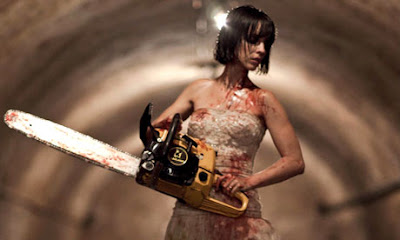
It opens in the now-familiar shaky-camera style. We’re at the wedding of Koldo and Clara. As the family and friends move on to the reception, however, it emerges that the Uncle’s dog-bite may be infected. Badly. Coughing blood and staggering, there are no prizes for guessing what happens next. It is, essentially, all fairly predictable. We’re ushered into a secure location (country house), introduced to the characters/victims (wedding guests) and then a zombie is thrown into the mix and all hell breaks loose.
That said, [REC]3 handles it all pretty well. The country house makes a refreshing change from the apartment block of before, the characters are (mostly) intelligent and likeable and, most crucially of all, the gore is good. Some cruel, splattery deaths are dealt to zombies and humans alike, characters are killed off, heads and limbs are hacked at. It’s gleeful, bloody stuff (which is exactly what we want, right?)
It’s certainly not as innovative or as well-crafted as the first film, I’ll accept that, but I’d say that it gave [REC]2 a pretty close run. [REC]3 is a well-made, straight-faced, zombie-movie. And I enjoyed it a lot.

Suspiria in a Swimming Pool
The Russian synchronised swimmers just did their routine to Goblin’s creepy and wonderful score to Dario Argento’s Suspiria!
Amazing.
(video via AVClub)